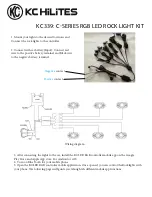
12
Regular maintenance
For a private use, we have chosen to stress on the main aspects of the maintenance of your landyacht.
Even if this list seems to be obvious for you, as you may know, a regular maintenance is paramount for a
safe and reliable operation of your landyacht given you may use it mostly on a beach. The following check-
list helps you to keep your landyacht in a good state.
-
Check any tightening’s (frame, tiller, axle
support, axles, front fork, spindles, wheels
steering fork...) before each session;
-
Only if you hear a noisy ball bearing, check
its lubrication and whether it is needed, add
some grease into it (open the gasket with
the tip of a knife, and press back the gasket
with your inches). Should the bearing still
making noise, then you can change it;
-
Wash (with clean water) the landyacht after
each use;
-
Regarding stainless steel components, if
you detect incipient rust, it’s not a big deal
as it is well known that in certain
circumstances, such as beach conditions
(mixture of salt and sand), even stainless
steel may experience some minor
corrosion. To clean this rust, use an
abrasive sponge, as this corrosion is only
superficial;
-
Check the steering system, if the fork pivot
makes noise, just add a drop of oil ;
-
As concerns the mast, check on a regular
basis the red adjustment strips and
reinforcements. Any degraded mast
location should immediately be replaced.
For a smart operation
For an easy start and easy
piloting, using the dogvanes
(also called “telltales”) stuck on
the sail is highly recommended.
Dogvanes are short wool
strands you can see close to the
leading edge of the sail (picture
38). The air flow is laminar
when the dogvanes are
horizontal. You need to focus
first on the extrados dogvane, I
mean the one behind the sail,
the one you can see through
the sail.
Dogvane
Dogvane
Picture 38: view of
the dogvanes (wool
strands) stuck on
the sail.


































